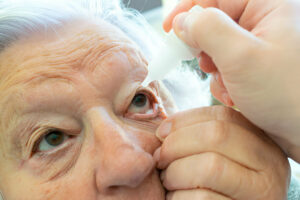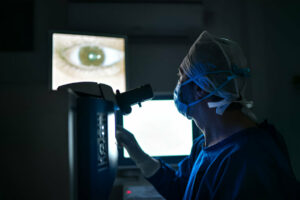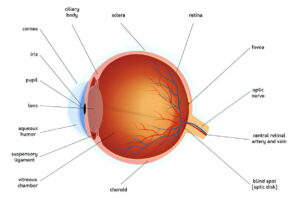
Trachoma is one of the leading causes of blindness worldwide and spreads when children come in contact with eye, nasal or throat discharge, or by touching someone who is infected. Repeated infections lead to scarring which causes eyelashes to turn inward, rubbing against cornea and causing irreparable damage and vision loss.
Symptoms
Trachoma is the leading infectious and preventable cause of blindness worldwide, caused by repeated infection with eye strains of Chlamydia trachomatis bacteria – distinct from genital strains which lead to sexually transmitted infection chlamydia (sexually transmitted infection). Trachoma thrives in areas with limited access to clean water, poor sanitation conditions and crowded living environments; easily spreading through personal contact (via hands, clothing or bedding) or through flies in contact with discharge from eyes or noses of those affected – becoming infectious themselves and contributing to blindness worldwide.
Trachoma symptoms typically develop over time and start as irritation of the tissue lining the inside of eyelids (conjunctivitis or pink eye), progressing to hard pimples called granules forming on their inner surfaces and leading to symptoms like tearing, light sensitivity or both. At later stages of disease blood vessels grow across corneal surface obstructing vision (known as neovascularization). Scarring can cause inward-turning eyelids which rub against cornea causing pain, itching and permanent blindness as damage to cornea can damage results in permanent blindness from scratching against its outer surfaces causing permanent blindness from this process.
At present, an estimated eight million people globally are visually impaired from trachoma; another 84 million live in endemic countries where it’s prevalent; most cases occur in poor areas, overcrowded spaces and unhealthy environments where sanitation conditions may not be the highest.
Trachoma can be easily treated with oral and topical antibiotics, with early treatment before scarring of the eyelid and cornea forms proving successful in curing it altogether. Unfortunately, due to lack of access and low priority given by governments in developing countries it often goes neglected; currently being a major public health concern in over 50 countries and particularly impactful against women and children. Education, training, improved sanitation, safe drinking water supply and antibiotic availability being key measures that can prevent it. WHO’s target goal is eradicating it by 2020
Diagnosis
Trachoma, caused by infection with Chlamydia trachomatis bacterium, is the world’s leading infectious blindness epidemic. Transmission occurs through contact with discharge from infected eyes or nose, usually children, or by handling shared towels and cloths; most prevalent in overcrowded communities with poor sanitation and hygiene; symptoms typically begin early in childhood before progressing to permanent loss of vision called “trachoma”.
Chronic inflammation of the conjunctiva begins as chronic irritation to its tissues lining the inside of eyelids (conjunctiva). Repeated infections cause scarring of this conjunctiva and over time this causes upper eyelid to turn inwards and rub directly against cornea, leading to itching, pain, and leaving a visible mark (trachomatous trichiasis). Rubbing causes scarring on cornea and scars can form, potentially leading to permanent blindness if not addressed properly.
Trachoma symptoms include itching and irritation of the eyelids, pus discharge from the eyes, light intolerance and pus discharge from swollen eyelids. A health care provider can diagnose trachoma with an eye exam – which includes looking for scarring or redness on the whites of eyes as well as checking for blood vessel growth into cornea. Furthermore, doctors can perform laboratory tests such as polymerase chain reaction tests to see if bacteria that cause trachoma are present.
People suffering from trachoma can be treated effectively with antibiotics if taken at the beginning of an infection, in order to eliminate or significantly reduce any corneal opacities and avoid future complications. Surgery may be required in extreme cases to correct eyelid deformities and stop the eyelashes from rubbing against the cornea, with women two to four times more likely than men to become blind due to trachoma. Diabetes can have a devastating impact on an individual’s life, restricting their ability to work and earn income while being unable to provide care for family members. Furthermore, this disease can cause depression and isolation as the individual cannot engage in activities or interact with others effectively.
Treatment
Trachoma, caused by an infection with Chlamydia trachomatis bacteria, is one of the leading preventable causes of blindness worldwide. It primarily affects poor people living in rural and developing nations where living conditions and sanitation is poor; most often those affected live in poor countries where living conditions and sanitation is poorer still. Repeated infections lead to scarring on the inside surface of upper eyelid (conjunctivitis); eyelashes become tightly attached to cornea causing it to rub against it as one blinks causing further damage over time; infection also leads to formation of abnormal blood vessels on cornea obstructing vision altogether.
Infection of the cornea occurs through direct physical contact or through sharing contaminated items like towels and washcloths that come into contact with eyes or noses, clothing or bedding shared among family and friends of an infected individual, including fly exposure. Most commonly affected are children between three and five years of age who show symptoms that progress slowly over time causing permanent corneal damage over time.
Symptoms of Trachoma include eye redness and watering, excessive eyelid itching, light sensitivity, blurry covering on the eyes (known as film), as well as blurriness or film on them. Over time it can progress until damage to the front cornea occurs which may be painful; in long standing hyperendemic trachoma areas mass antibiotic distribution as well as surgery may be needed to decrease risk of blindness.
Antibiotics like azithromycin, doxycycline or tetracycline may be prescribed by mouth or eyedrop to stop bacteria from multiplying and reduce long-term complications. Surgery to remove infected tissue and correct trichiasis may also be required in cases of advanced trachoma.
Trachoma infection can be reduced through practicing good hygiene. Regular facial washing with potable clean water is an effective way to control its spread, as is sharing towels, washcloths and face rags with others. Clean water supply and improved sanitation systems are of critical importance in regions with an endemic problem such as trachoma.
Prevention
Trachoma is a preventable eye disease caused by repeated episodes of keratoconjunctivitis (inflammation of the cornea and conjunctiva). Over time, infection can lead to scarring that causes eyelashes to turn inward towards the eyes – this condition known as trichiasis – eventually rubbing against the cornea and eventually leading to permanent damage; those blinded from trachoma lose the ability to work or take care of their families; women are twice as likely to become blinded from this disease than men; often having had to stay home as caregivers for family members suffering from it.
Chlamydia trachomatis is the cause of trachoma. It spreads by direct contact between infected persons’ hands or clothes or through flies carrying discharge from eyes; and is especially prevalent among poor rural communities of Africa, Asia, Latin America, the Middle East, and Australia – becoming one of the leading infectious causes of irreversible blindness worldwide.
World Health Organization recommends an approach known as SAFE (Surgically Adjusting Trichiasis, Antibiotic Treatment with Pfizer-Donated Azithromycin, Facial Cleanliness and Environmental Improvement to address Root Causes of Vulnerability) to combat trachoma. These strategies aim to decrease its prevalence while simultaneously improving vision outcomes.
Regular eye examinations can detect abnormal reddening of the whites of eyes, signs of trachoma and abnormal blood vessel growth across the cornea – key information needed for community-based approaches to eliminating trachoma. At NEI we are leading efforts to develop and implement an easily detectable local system for detecting Chlamydia Trachomatis bacteria which will detect it rapidly in eye samples taken for testing at local level.
As part of a comprehensive education campaign to teach children the value of practicing good hygiene, regular washing of face and hands with soap is recommended, keeping facial hair clean, wearing clean clothing and not sharing towels are also effective in protecting against eye infections such as trachoma.








